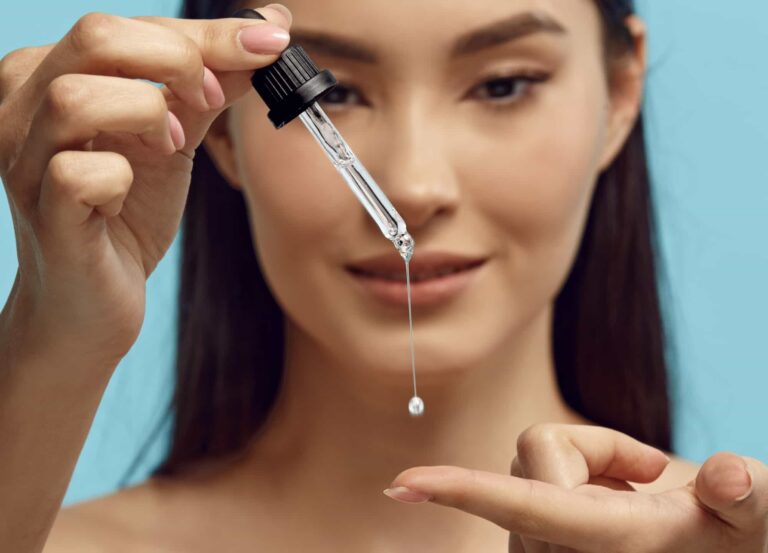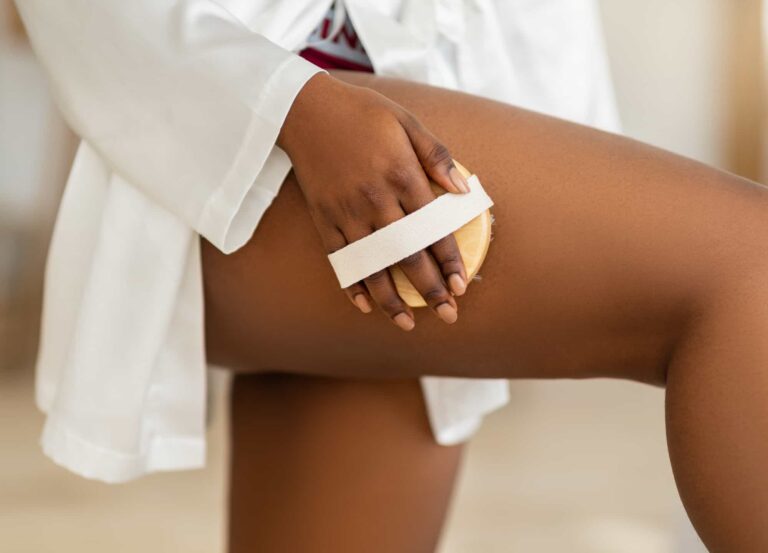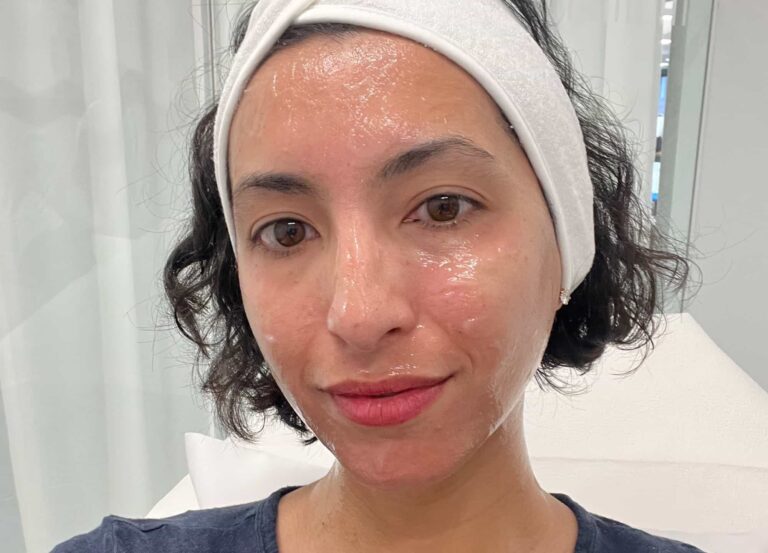Clogged pores and hormonal acne are common enough that there are countless products and treatments specifically targeted to those issues. But knowing how to deal with other types of skin conditions, like milia under the eyes (which is also known by the slightly uncomfortable nickname “milk spots”) can be a little less apparent. After all, there doesn’t seem to be a product in existence that’s labeled “anti-milia solution,” at least not yet, so treating those little white bumps under your eyes is a bit more complex than tackling your average breakout.
According to the American Osteopathic College of Dermatology (AOCD), a milium is a common type of skin cyst, so it might be useful if there were more information out there on how to battle these little suckers. Ahead, three skin experts give us tips on how to prevent and get rid of milia under the eyes, with both at-home remedies and in-office treatments.
What is milia?
Milia, also known as milium cysts, are small, pearly white or yellow bumps that are commonly mistaken for whiteheads, under the eye. According to Dr. Michele Green, a board-certified dermatologist in New York City, these tiny cysts are formed due to a buildup of dead skin cells, keratin, and sebum, which get trapped beneath the skin surface and cause tiny raised white bumps. “Milia are often mistaken for whiteheads, but the distinction is that they can be extracted and do not need acne medication for treatment,” she says. They also don’t always appear as clusters. What you might assume is a white pimple under your eye might just be a milium riding solo. “[Milia are] benign,” Dr. Shari Sperling, a dermatologist in Florham Park, New Jersey, explains. “You can have one or several. It usually occurs on the face, around the eyes, but can occur in other areas too.” However, the white, dome-shaped appearance of milia distinguishes itself from similar types of conditions on the body—for example, the red, bumpy keratosis pilaris (chicken skin) commonly found on the upper arms.
Related: 10 Concealers Almost As Good As Under-Eye Filler
What causes milia under the eyes?
There are various types of milia. According to a 2017 study in the Journal of the American Academy of Dermatology, primary milia, which is the most common aside from neonatal or congenital milia (a kind that babies get), usually develops spontaneously “in healthy skin with no clear [cause].” Secondary, or traumatic, milia can develop as a result of damage to the skin, such as from burns; sun damage; resurfacing procedures, like lasers; or reaction to a medication or even a heavy skin-care product. One study from the Journal of Drugs and Dermatology reported a form of milia that occurred within a tattoo. There are also rarer forms of milia, such as milia en plaque, which appears on the face or body in clumps. Multiple eruptive milia (MEM) is another rare type of milia that’s characterized by a sudden onset of multiple milia over weeks or months, without any obvious cause.
Why does milia often occur around the eyes?
As to why milia frequently occurs around the eyes, it might be due to the skin in the area, Dr. Ava Shamban, a dermatologic surgeon in Beverly Hills, California, theorizes. “It is unclear why the eye area is so common, but perhaps it’s due to the tiny glands circling the eye,” she says. It’s also worth pointing out that because we’re generally told to avoid the eyes when using certain cleansers and other facial products, sometimes that area, where the skin is thinner and more delicate, might not be getting properly cleansed or exfoliated. (Think about how much concealer or eye cream might build up!) Celebrity aesthetician Renée Rouleau has also noticed an increase in milia among people who smoke cigarettes. “It could be that smoke is blown upward into the eye area, causing a keratinization of the skin,” she wrote on her blog.
And compared to other eye-area skin conditions, like zits or styes (which can appear as a bump near the eye corner), milia usually isn’t accompanied by pain or itchiness. It is also different from a chalazion, or meibomian cyst, which happens when a gland on the eyelid becomes blocked or inflamed.
How long do milia last?
Sometimes, milia go away on their own, but there have been cases where those little white bumps lasted several years. In a 2016 study from the medical journal Oncology Letters, a woman had the same milia on her face for an entire decade! If you have a milia breakout, you can usually continue to wear makeup, though the raised, bumpy appearance may result in uneven-looking texture. Just make sure to thoroughly wash off your makeup every day.
Related: 6 Nonsurgical Ways to Treat Aging Eyes
Who can get milia?
While newborn babies and infants are prone to milia, Dr. Green says that anyone can be susceptible to it, regardless of skin type or age. However, she says that it does tend to run in families. The rare milia en plaque type is known to mostly affect middle-aged women.
How can you prevent milia under the eyes?
Since primary milia can be a mystery, since they sometimes occur without any rhyme or reason, there are some things you might want to consider trying if they end up becoming a frequent problem. When it comes to preventing milia under the eyes in the first place, as with many things to do with skin, it might very well depend on your skin care routine. As Dr. Shamban says, you’ll want to be “very diligent” about it. Make sure to have a solid cleansing regimen, and if you wear makeup (especially heavy eye makeup), it might be worth adopting a double-cleansing method.
What are the best products to get rid of milia?
If milia under eye removal is a top priority, remember this one rule: no matter what you do, be mindful of the products you use. Dr. Green believes using a lightweight, lipid-free cleanser is best, so something like La Roche-Posay Toleriane Hydrating Gentle Facial Cleanser might help keep milia at bay. She also says to use a toner, to help open the pores, and to choose one with alpha hydroxy, salicylic or glycolic acid, such as SK-II Facial Treatment Clear Lotion or GlamGlow Supertoner. “These ingredients facilitate cell turnover and remove dead skin cells,” she explains. “Finish by using a lightweight moisturizer, since moisturizing replenishes the skin and hydrates your skin cells. Ingredients to look for are hyaluronic acid, [in] gel-based or lightweight formulas. These elements provide your skin with the nourishment it needs, without clogging the pores.” Dr. Sperling also suggests using an over-the-counter glycolic cleanser. Something like Kate Somerville ExfoliKate Cleanser Daily Foaming Wash or Ole Henriksen Find Your Balance Cleanser—both of which contain glycolic acid—may help.
Above all, in order to potentially prevent or minimize milia formation, “Your facial products should be lightweight, and you should avoid ones that contain mineral oil and petroleum,” Dr. Green says, as those are the worst products to use when dealing with milia (they are heavy and pore-clogging). In addition, she says that adding a targeted exfoliating treatment for milia to your skin-care routine can help decrease the formation of the spots, which is seconded by Dr. Shamban. “Include acid exfoliators and make sure you are thoroughly cleansing your face,” she says, adding that using topical retinoids, which increase cell turnover, can help prevent them. Something like Dr. Dennis Gross Ferulic + Retinol Triple Correction Eye Serum might be a good product to try instead of a thicker eye cream.
It also wouldn’t hurt to keep your glasses sanitized. More often than not, we forget to regularly clean our glasses and sunglasses—and if you’re noticing those little white dots popping up under your eyes in the same place where the frame sits, there might just be a connection.
In-office treatments for milia
Though milia is generally harmless, it’s understandable if you’re not happy with their appearance and want to get rid of them. This is where a licensed professional, like a board-certified dermatologist, comes in. “Your dermatologist can safely and effectively extract milia for you,” Dr. Green says. “One of the most common treatments is to extract the milia using a small lancet that removes a tiny part of the skin over the milia. Once the pore is open, it will allow your dermatologist to remove the contents of the milia.”
Other professional treatments might include electrodessication, which uses an electric current device to cauterize and destroy the milia, as well as cryotherapy, which freezes the cysts.
At-home treatments for milia under the eyes
When it comes to at-home remedies for milia, there are some things people swear by, like natural methods, such as rosewater and honey, that are known to be anti-inflammatory. But nothing will compare to getting them professionally extracted. Dr. Sperling suggests steaming the skin and gently exfoliating, using a “rough washcloth to lightly rub the area,” which might help to at least prepare the roof of the milium to open. However, you should never try removing milia yourself. Remember, they aren’t like regular pimples, so it can be extremely risky if you try to pop them. “You should not attempt to squeeze or try to extract them on your own, as this can cause trauma to the skin and scarring,” Dr. Green says.











